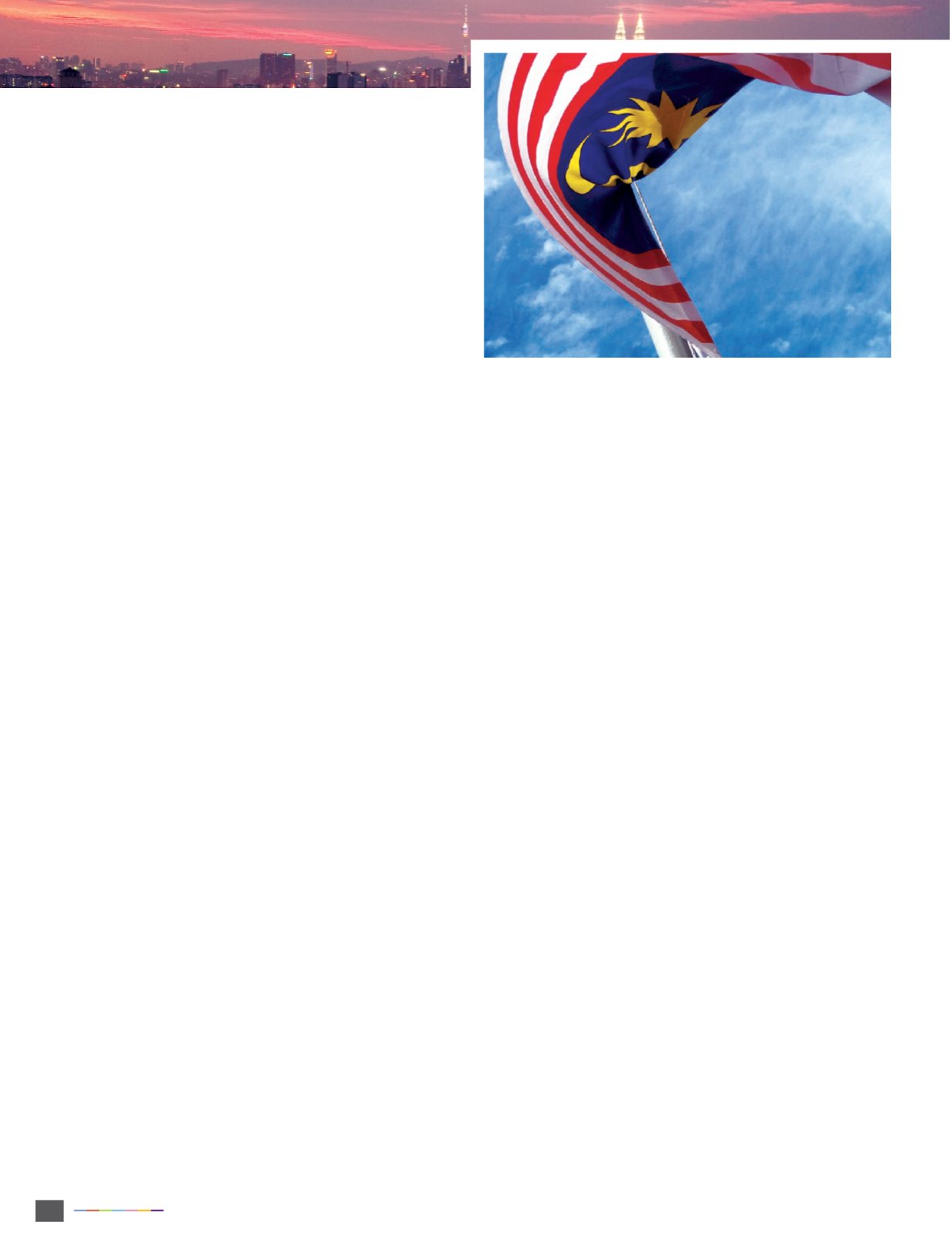
Food Focus Thailand
JUNE 2013
34
เป
นกลุ
มอุ
ตสาหกรรมที่
มาเลเซี
ยมี
ความถนั
ดและต
องการจะพั
ฒนา
ความสมบู
รณ
ของไลน
การผลิ
ต เพื่
อส
งเสริ
มความสามารถในการแข
งขั
น
ในตลาดส
งออก (กรณี
ของกลุ
มเครื่
องใช
ไฟฟ
าและอิ
เล็
กทรอนิ
กส
) รวมทั้
ง
ยั
งเป
นอุ
ตสาหกรรมพื้
นฐานที่
มี
ความสำคั
ญต
อการต
อยอดในอุ
ตสาหกรรมอื่
นๆ
(กรณี
ของกลุ
มโลหะพื้
นฐานและเคมี
ภั
ณฑ
) ซึ่
งนั
กลงทุ
นของทั้
งสองกลุ
ม
อุ
ตสาหกรรมนี้
ส
วนใหญ
จะมาจากกลุ
มเอเชี
ยตะวั
นออก (ญี่
ปุ
น เกาหลี
ไต
หวั
น) หรื
อจากชาติ
ตะวั
นตก (สหรั
ฐอเมริ
กา ฝรั่
งเศส)
ธุ
รกิ
จที่
ไทยมี
ศั
กยภาพในการลงทุ
นในประเทศมาเลเซี
ย
สำหรั
บนั
กลงทุ
นไทยเอง อุ
ตสาหกรรมที่
หลายประเทศให
ความสนใจลงทุ
น
เช
น เครื่
องใช
ไฟฟ
า และอิ
เล็
กทรอนิ
กส
ดู
เหมื
อนจะไม
ใช
เป
าหมายของ
นั
กลงทุ
นไทยมากนั
ก เนื่
องจากฐานการผลิ
ตในมาเลเซี
ยจะมุ
งเน
นที่
การวิ
จั
ยและพั
ฒนา (Research and Development; R&D) และ
การออกแบบและพั
ฒนา (Design & Development; D&D) ซึ่
งต
องอาศั
ย
ความพร
อมด
านความสามารถทางเทคโนโลยี
และความถนั
ดด
านการผลิ
ต
ซึ่
งต
องใช
กระบวนการที่
ค
อนข
างซั
บซ
อน ในทางกลั
บกั
นมาเลเซี
ยเอง
กลั
บย
ายภาคการผลิ
ตที่
ต
องใช
แรงงานราคาถู
กมาที่
ประเทศไทย
เสี
ยมากกว
าศู
นย
วิ
จั
ยกสิ
กรไทยพบว
าหนทางการลงทุ
นของนั
กลงทุ
น
จากไทยในมาเลเซี
ยมั
กจะเบนเข็
มเข
าหากลุ
มอุ
ตสาหกรรมที่
ตน
มี
ความชำนาญในเชิ
งเปรี
ยบเที
ยบ เช
น ธุ
รกิ
จอาหารและวั
สดุ
ก
อสร
างและ
อุ
ปกรณ
ขนส
ง เป
นต
น โดยป
จจุ
บั
นพบว
าเครื
อข
ายธุ
รกิ
จรายใหญ
ของไทย
ในวงการอาหารและวั
สดุ
ก
อสร
างได
เข
าไปลงทุ
นในมาเลเซี
ยแล
ว
สำหรั
บทิ
ศทางการลงทุ
นในระยะข
างหน
านั้
น ศั
กยภาพของธุ
รกิ
จไทย
ที่
จะไปลงทุ
นในมาเลเซี
ยยั
งมี
อยู
ซึ่
งหากพิ
จารณากลยุ
ทธ
ของมาเลเซี
ยที่
จะ
มุ
งเน
นการเป
ดเสรี
ภาคบริ
การมากขึ้
น ขณะที่
ประชากรของมาเลเซี
ย
เป
นกลุ
มประชากรที่
มี
รายได
ค
อนข
างสู
งและมี
กำลั
งซื้
อมาก ประกอบกั
บ
จุ
ดแข็
งของผู
ประกอบการไทยในด
านการผลิ
ตอาหารและภาคบริ
การ
ศู
นย
วิ
จั
ยกสิ
กรไทยมองว
า ธุ
รกิ
จกลุ
มอุ
ตสาหกรรมแปรรู
ปอาหารประเภท
ฮาลาลซึ่
งมี
ความจำเป
นต
อประชากรส
วนใหญ
ที่
เป
นมุ
สลิ
ม เช
น มาเลเซี
ย
และธุ
รกิ
จการใหการบริ
การ เช
น สปา การท
องเที่
ยว น
าจะเป
นธุ
รกิ
จดาวรุ
ง
ที่
ผู
ประกอบการไทยสามารถเข
าไปชิ
งส
วนแบ
งการตลาดได
ไม
ยากนั
ก
สำหรั
บทิ
ศทางการลงทุ
นในระยะถั
ดไปคงจะต
องจั
บตามองการดำเนิ
น
กลยุ
ทธ
ปรั
บเปลี่
ยนประเทศไปสู
กลุ
มประเทศผู
มี
รายได
สู
งของรั
ฐบาล
มาเลเซี
ยภายใต
NEM โดยใช
กลุ
มเศรษฐกิ
จหลั
ก (National Key
Economic Areas, NKEAs) ทั้
ง 12 กลุ
ม ดั
งนี้
1. กลุ
มพลั
งงาน 2. ปาล
ม
น้
ำมั
นและยาง 3. ธุ
รกิ
จการเงิ
น 4. ธุ
รกิ
จการท
องเที่
ยว 5. บริ
การทางธุ
รกิ
จ
6. ไฟฟ
าและอิ
เล็
กทรอนิ
กส
7. ค
าปลี
กค
าส
ง 8. การศึ
กษา 9. การแพทย
10. การสื่
อสาร 11. เกษตรกรรม และ 12. Mega City Greater Kuala
Lumpur/ Klang Valley น
าจะผลั
กดั
นให
มาเลเซี
ยก
าวข
ามผ
านสถานภาพ
ของประเทศที่
ถู
กใช
เป
นฐานการผลิ
ตสิ
นค
าอุ
ตสาหกรรมไปสู
ประเทศ
ที่
มุ
งเน
นภาคบริ
การและสิ
นค
าเทคโนโลยี
ขั้
นสู
งมากยิ่
งขึ้
น
integrity of the production line to enhance competitiveness in the
export market (in case of appliances and electronics). They are also
an important industrial base to induce other industries (in the case of
base metals and chemicals). Majority of investors of the two industry
groups come from East Asia (Japan, Korea and Taiwan) or from the
West (USA and France).
Potential for Business of Thailand to Invest in
Malaysia
For investors of Thailand, many industries such as consumer
electronics and electronics that interested various investors seem
not to the target of many investors from Thailand. The manufacturing
base in Malaysia is focused on the research and development (R&D)
and design and development (D&D) which requires the availability of
technological capabilities, and expertise in the production requires
relatively complex processes. On the other hand, Malaysia moves
back to the manufacturers to use cheap labor in Thailand. Kasikorn
Research Center found that investors of Thailand in Malaysia tend
to deflect toward the industries in which they have comparative
expertise such as food, transportation, construction materials and
equipment etc. Currently, the largest business network in the food
and construction material industry of Thailand starts to invest in
Malaysia.
For future investment direction, capacity of Thai business to invest
in Malaysia is still available. By considering that Malaysia has strategy
to focus on the services sector liberalization where the population of
Malaysia has a relatively high income and strong purchasing power,
and the strength of Thai enterprises in the manufacturing and service
sectors, Kasikorn Research Center said that the business model of
halal food processing industry which is necessary for the majority
of the Muslim population like Malaysia, and businesses providing
services such as spa, tourism, will be the young business where Thai
entrepreneurs may compete for market share without difficulty.
For direction for investment in the next phase, we would continue
to look for strategies to change the country into the group of countries
with high income the Government of Malaysia is pushing under the
NEM by using all 12 major economic groups (National Key Economic
Areas, NKEAs). These include 1. Energy 2. Palm oil and rubber.


